It wasn’t the best of weather as I made my way across London to Whipps Cross in the north-east of the capital. It’s on the edge where Walthamstow and Leytonstone meet Epping Forest, and around 500 years ago or more, the family of John Phyppe set up a cross to him at a lonely meeting of roads. It still feels a rather lonely place, but has a large and busy roundabout, and a hospital. It still has a cross, but a rather more modern one, a war memorial erected a mile or so away after the ‘Great War’ for the Essex Regiment of the Territorial Army, moved here when a large Victorian house became a TA centre.
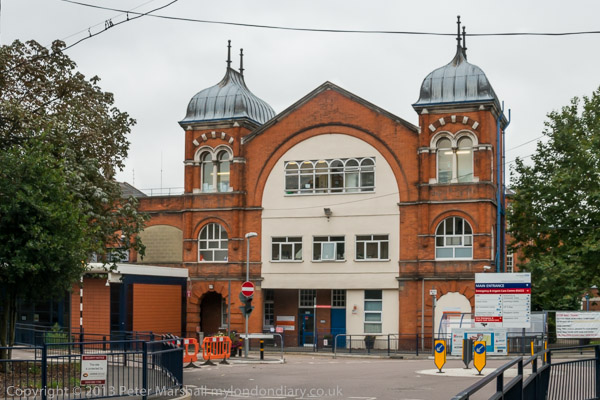
The Hospital also started – just – in the Victorian era, building starting in 1900, though it wasn’t finished until 1903 – it was a large hospital for the era, and a lot has been added since. Its now part of Barts Health NHS Trust and threatened with huge cuts not because of its own problems (largely solved by previous efficiencies) but because of the huge PFI repayments for the new Royal London Hospital in Whitechapel.
It was drizzling when I got off the bus and walked up the drive to take a look (and photograph) the old main entrance before joining the few hundred protesters who were gathering on the green next to the roundabout. Not hard enough to really get you wet, but enough to put the odd spot of rain on your lens when you least expected it, and I was keeping my microfibre cloth out and covering the lens as I walked around.
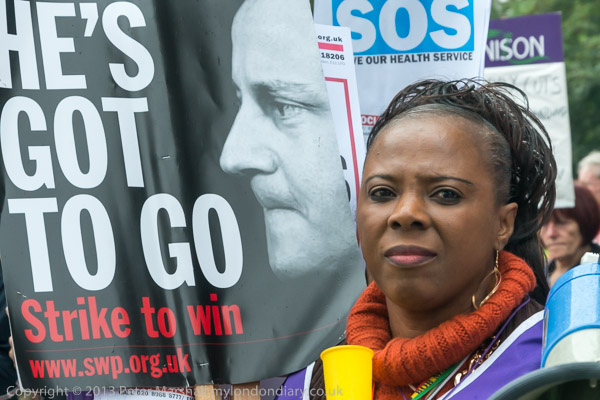
18-105mm at 75mm (112mm eq), D800E DX format
Once the speeches started it was easy to take photographs, with a nice amount of space for photographers between the audience and the small platform. There weren’t too many photographers, and better still not many videographers and it was easy to move around without getting in anyone else’s way. Working with people who are taking video is often difficult, as still photographers generally want to move around and movie photographers usually prefer to stay still, and still photographers often want to go in much closer to take pictures. It can cause friction and often does.
I was using both the 18-105mm and the 70-300mm on the D800E, working with both on the DX format, although the 70-100 is a full-frame lens. I like being able to see the area outside the frame, and the 16Mp DX images are plenty big enough. The 70-300 was a better lens for head and shoulders or tightly frames heads of the speakers, while the 18-105mm was good for picking out individuals or small groups in the crowd. There is a useful amount of overlap between the two lenses which saves a little lens changing. The image above could have been taken with either.
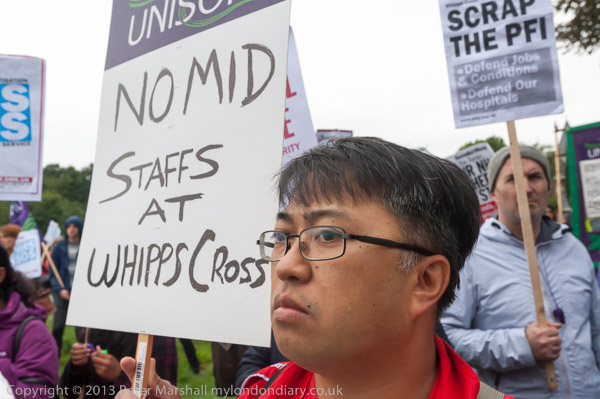
16-35mm at 31mm, D700
As well as being useful for picturing larger groups, the 16-35mm also lets me get in close. Again there is a useful overlape between this lens and the 18-105mm DX (27-157mm equiv) and I could have used either for this image.
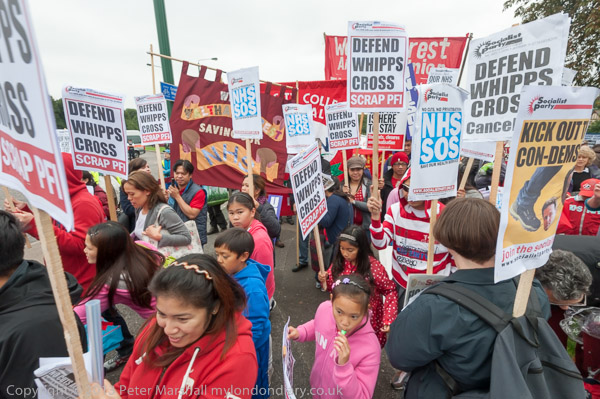
16-35m at 16mm, D700
I don’t much like climbing up on walls etc these days, and unless I’ve got something pretty good to hold on to I tend to start shaking rather a lot, and sometimes have to get down pretty quickly or I would fall off. But there was a very handily placed seat in the right place that I could stand on and feel pretty safe while still getting to look down a little on the march
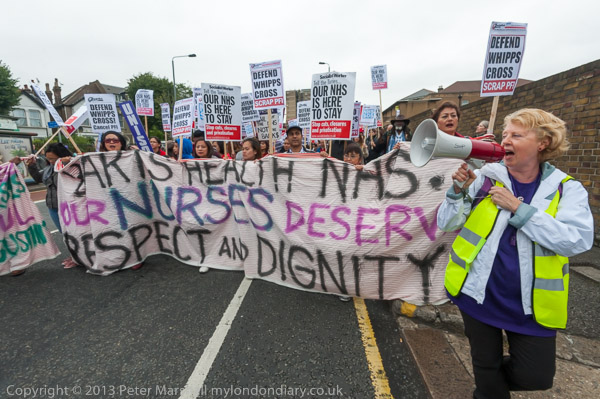
16-35m at 16mm, D700
The wide angle also came in useful as I was walking (backwards) with the march, letting me include the Unison shop steward quite close to the camera at right and the whole of the rather wide banner. It was reasonably bright and at ISO 640 the exposure was 1/400 at f10, and with a 16mm lens at those settings there is plenty of depth of field and little risk of camera shake even though I’m walking.
I think photographers somehow develop a smoother movement with practice. Back when I taught photography I had to spend a lot of time telling students how to avoid camera shake. You have to stand still, tuck those elbows in to your side, press the camera against your head and make yourself and the camera a solid block, then squeeze not jab on the the release. Yet many still managed to get camera shake. Of course they were mainly working with standard focal length lenses, and using film at ISO 125 or 400; wider lenses and higher ISO make life easier, (and so does image stabilisation) but in part I think it’s in the mind, thinking steady helps.
It’s perhaps better to keep moving than to stand still, because even in 1/400s, a person walking will move perhaps 1/8″, and if you are moving at the same speed and in the same direction the distance won’t change. The effect of movement would in any case be less for someone walking towards you, while people walking across the field of view will show the effect of their motion more, and the effect will be greater the closer they are to the camera. Arms and legs in particular are also moving at greater speed than the actual movement, so more likely to suffer motion blur. But a little blur, particularly if the eyes and face remain sharp, is usually a good thing.
The main reason to keep moving when photographing marches is that if you stand still, people are more likely to stop. And the last thing you want people to do when you are photographing them moving is for them to stop.
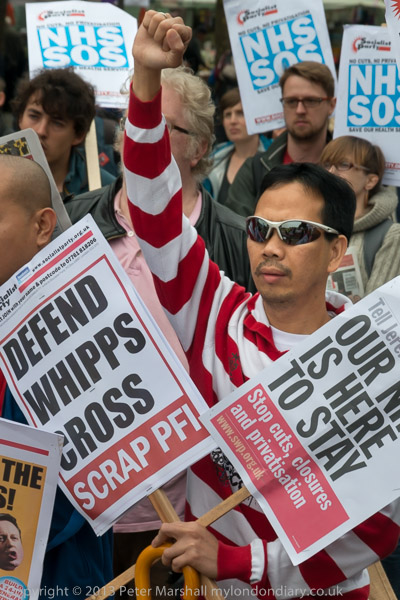
The march ended at Town Square in Walthamstow with more speeches, and again both the 70-300mm and the 18-105mm were useful, the longer lens mainly for the speakers, and the shorter for people in the crowd – though again the picture above, taken at 105mm (157mm), could have been made with either. If I know I’m unlikely to need an extreme wide angle (or a very long lens), I often put the 70-300mm on the D700 and use it full frame, though I didn’t think to do so here.
More pictures (and of course more about the protest and background) at Save Whipps Cross Hospital
______________________________________________________
My London Diary : Buildings of London : River Lea/Lee Valley : London’s Industrial Heritage
All photographs on this and my other sites, unless otherwise stated are by Peter Marshall and are available for reproduction or can be bought as prints.
To order prints or reproduce images
________________________________________________________